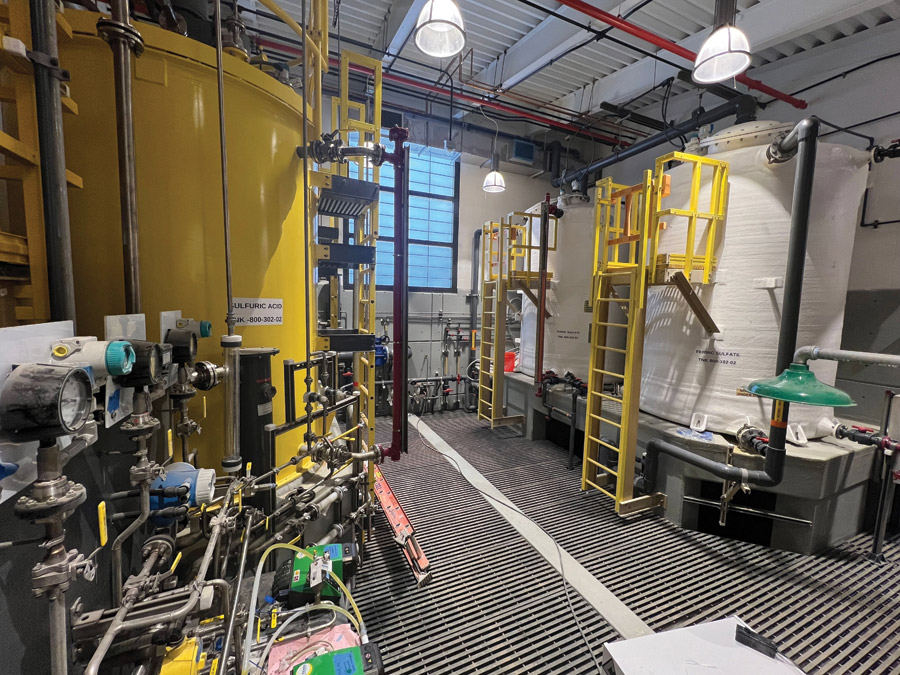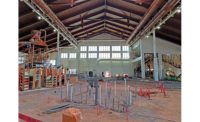Digging Deeper | Water/Environment
Improving Water Quality For Park City Streams

The Three Kings Water Treatment plant packs a multitude of green features into one facility within a sliver of a site on the Park City golf course.
Photo courtesy Park City Public Utilities
For city water managers and residents of the 1860s-era silver mining town turned chic mountain resort Park City, Utah, there is light at the end of the tunnel. The $80-million, 60,000-sq-ft Three Kings Water Treatment Plant (3KWTP), the crowning feature in a $135-million capital improvements program launched in 2013, is nearing completion. Part of that program includes the Judge and Spiro mine drainage tunnels, which supply 30% of the drinking water supply for the town of nearly 9,000 residents located 40 miles southeast of Salt Lake City.
While the project will improve the quality of the town’s drinking water supply, that was not the driving force behind the need for the new facility, explains Roger McClain, engineering manager for Park City’s Public Utilities.

Fitting everything on the narrow site meant deep excavations and stacking operations. Plant operators work on floors above raw water basins. At left, raw water enters the first stage of treatment.
Photo courtesy Park City Public Utilities
“Improving the water quality in the streams is what is driving this,” McClain says, referring to the fact that in addition to contributing to the city’s drinking water supply, the flows from the tunnels also make up the headwaters of McLeod Creek, a tributary to the Weber River and Great Salt Lake.
Referred to by the EPA as mining influenced water, the tunnel water contains varying levels of arsenic, iron, manganese, cadmium, lead, zinc, iron, antimony and thallium. While a portion of the water is treated to potable levels, some raw water traditionally has been discharged into local creeks.
“The requirements for water going into the streams are actually stricter than for drinking water,” says Michelle DeHaan, the water quality and treatment manager for Park City’s Public Works department. “The wildlife in the creek and [the animals] that drink the creek water are actually more sensitive to lower levels of contaminants than people.”
In 2015, the city entered a stipulated compliance order with the Utah Division of Water Quality laying out a timeline for compliance and treating the water.

Rather than the open concrete pools at typical water treatment plants, the two 84,000-gallon gravity thickeners are enclosed. The tanks are wrapped with material that reflects the mining history of the site.
Photo courtesy Park City Public Utilities
Entering the Tunnel
The new facility occupies the same site as its predecessor, the Spiro treatment facility, which was demolished. In anticipation of removing one of the city’s two treatment facilities as well as future growth, Park City constructed a small treatment plant known as Creekside that opened in 2017.
According to Joseph Zalla, lead process engineer and deputy project manager at the Salt Lake City office of Texas-based engineering firm Jacobs, the 3KWTP facility presented the engineering team with unique challenges.
“It's quite an amazing facility, but it was not easy to build.”
—Eric Alder, President, Alder Construction
The facility treats water for discharge purposes and also treats it to drinking water standards. “It has the same initial process regardless of where it is going,” Zalla says. “What is unique is the treatment required to meet both standards.”
While removing toxic metals from drinking water was not uncommon, Zalla says the presence of so many, along with antimony and thallium, added a level of complexity to the process.
“Thalium and antimony themselves require unique processes that in most municipal drinking water treatment plants you just don’t have to deal with,” he says.
“The last step is the titanium dioxide absorbers, and those will remove the antimony and at that point the city can decide to send it into the stream or into the drinking water system,” Zalla says.
Zalla and the design team and city officials developed virtual models before constructing and testing a scale model for a year in 2016 to prove their concepts. The modeling was also useful in working out how buildings on the site could be placed and where separations could occur to distribute the overall mass.
DeHaan says water going to the drinking water system is sent through a final disinfection with chlorine and UV light, and the pH is adjusted from 6.5 to 7.8. The new plant will produce its own chlorine on site to ensure supply and reduce neighborhood truck traffic.

Chemicals are housed in one of eight separate structures on the site. The plant generates its own chlorine to eliminate the need to store material on site and to reduce truck traffic through the neighborhood.
Photo by Brian Fryer for ENR
Access and Complications
“The wildlife in the creek that drink the creek water are actually more sensitive to lower levels of contaminants than people."
— Michelle DeHaan, Water Quality and Treatment Manager, Park City Public Works
“When we looked at how much space we needed, we were at about 60,000 square feet [the finished footprint is 48,000 sq ft], and the city said, ‘You’ve got 1.92 acres so get it to fit,’” says Eric Alder, president, Alder Construction, the project’s construction manager/general contractor. “We had to excavate down and put the settling basins underneath the building and just start stacking things.
“It’s quite an amazing facility, but it was not easy to build,” Alder concedes. Excavation on the site went 20 to 30 ft below grade in some areas, and Alder says that even after a year of preconstruction and sequencing work, construction was difficult with limited access to the site, a winter with higher-than-average snowfall and then the surprise of the COVID-19 pandemic.
“We signed all the contracts before COVID-19, and that really threw a wrench into everything. We had missing man hours, material we were planning on suddenly wasn’t coming and so we had to work with the city and the architect to look for alternatives,” he says. Concrete shortages and rationing by local suppliers in 2021 further complicated the concrete-heavy project.
The limited space on the site meant materials were sometimes stored at other locations on the golf course or at Alder’s warehouses in Salt Lake City. Workers had to be shuttled from parking lots at the edge of town.

The chemical mixing controls are centralized and can be monitored and operated remotely when necessary.
Photo by Brian Fryer for ENR
Mining Inspired Design
Project architect David Kaselak with Zehren & Associates of Avon, Colo., says the team drew on the town’s mining history for the forms and exterior finishes of the buildings and how the total mass was distributed on the site. “The design features traditional mining forms and materials mixed with contemporary forms and materials as well. Portions of the new plant appear to emerge from the site of the original [Spiro plant],” Kaselak says.
Attention to the aesthetics of the mountain town and processing water from old mining tunnels are not the only features that make it different from many other water treatment facilities. While municipal water treatment plants are often located out of sight from the public or in industrial areas, the 3KWTP occupies a narrow, 2-acre strip between two holes on the busy municipal golf course off a tree-lined street with upper-end mountain homes and condominiums.
“The city was very sensitive to the location of the building within a public golf course and surrounded by upscale residential architecture. We were tasked with complementing the context of the site and creating a campus using many smaller scale building forms rather than a few immense buildings,” Kaselak says.
Other Upgrades
While the Three Kings Water Treatment Plant is the most visible and largest component of a wider upgrade to Park City’s drinking water system, other upgrades include:
The $13.6-million Judge tunnel pipe improvements:
The Judge tunnel produces around 800 gallons of water a minute. The pipes for raw water from the Judge tunnel and lines delivering potable water to storage tanks around the city were replaced. In all, 4.1 miles of 12, 16 and 18 metal pipe were replaced with HDPE.
The $7.8M golf maintenance and city staff facilities:
The 3KWTP displaced a golf course maintenance and administration facility. A new 8,200-sq-ft building was constructed at another location at the edge of the golf course.
The $4.6-million Spiro tunnel upgrades:
Park City maintains about 13,000 ft of the Spiro tunnel, which produces around 3,400 gallons of water a minute while the Judge tunnel to the south in Empire Canyon and the artesian Theriot Spring produce around 800 gpm each for the city water supply. An inspection of the tunnels in 2018 showed some destabilization along the first 400 ft of the tunnel, and a mine construction team placed shotcrete on the walls. A new public plaza was built at the tunnel entrance with information and historic photographs.
The $3.9-million golf course pond improvements:
Treated water from the 3KWTP is released into an adjacent holding pond on the golf course where it can be used for irrigation and snowmaking at the nearby Park City Mountain.
The $1.65-million surge tank replacement:
The aging 1-million-gallon steel tank in Empire Canyon collects water from the Judge tunnel and controls its release into the system. The tank was demolished and replaced with a 0.2 million gallon buried concrete tank.
Net Zero
The mass of the facility is distributed on the site and broken into separate buildings. Some roofs sport PV panels or are planted with living turf like those often found in European alpine environments. The building is designed to comply with the 2017 mandate from the city that all new municipal buildings meet net-zero energy performance.
A system of heat exchangers utilizes the cold water entering the facility to help heat and cool the building, and the natural water pressure in the raw water supply lines is harnessed by micro-hydro generators to produce electricity. The PV systems on the roofs and micro-hydro generators should produce about 30% more energy than the building uses, according to information from project leaders.
The 3KWTP can produce up to 7.2 million gallons of potable water per day.
In August of 2023, engineers began 60 days of commissioning tests on the processing equipment. After successful tests, the plant began delivering water in late November. The building includes office space for the public works staff, along with interior finish work that will continue through the winter with an official opening slated for June.




